Arizona has not been the most advanced place in terms of progressive energy policy. The state’s regulators were the first to allow utilities to impose discriminatory charges upon owners of PV systems, and its renewable energy standard has one of the weakest targets of any such mandatory policy in the United States.
However, this could change if the vision adopted by one of the regulators at the Arizona Corporation Commission (ACC) is adopted. Today Commissioner Andy Tobin laid out a new vision for a clean energy future for the state, involving an 80% by 2050 clean energy goal, a 3 GW energy storage target and plans for electric vehicles.
Arizona’s Energy Modernization Plan would be a comprehensive effort, which is cast as an effort to update the state’s Renewable Energy Standard and Tariff (REST), but would go well beyond the policy’s unambitious goals. Instead, the plan declares that policies should work towards a “singular, unifying goal” for Arizona to get 80% of its electricity from “clean energy sources” by 2050, with an ultimate goal of 100% at a later, un-specified date.
It is unclear what exactly the plan means by “clean” energy. While the document declares that the technologies in the existing REST program will not be altered, it is unclear whether the new Clean Resources Energy Standard and Tariff (CREST) would include such sources as nuclear power, in line with the attempts of nuclear advocates to brand such generation as “clean”.
If it does include nuclear power, this could be a boost to Arizona Public Service and the other owners of the Palo Verde nuclear plant. However, it is unlikely that it would spur the deployment of new nuclear power plants in Arizona, at least until such time as newer technologies are commercially available, as the high costs and complications of existing nuclear technology are leading to cancellations even among the few projects currently planned.
The plan definitely includes energy storage, and a central part of this plan is a target for 3 GW of energy storage, with a “variety of sizes, ownership structures and technologies” by 2030. This would include batteries, as well as mechanical, thermal and “gravitational” storage.
This energy storage will be critical for another central component of the plan, a “Clean Peak Standard”, under which a portion of clean energy resources must be available to meet demand during the four-hour peak window that utilities designate. This could also be an opening for nuclear power, or for energy storage.
According to the plan, regulated utilities will quantify existing levels of “clean resources” to be deployed during peak hours to establish a baseline, and incrementally increase that baseline 1.5% annually until 2030.
The plan expressly permits the retrofitting of existing renewable resources to maximize effectiveness during peak periods. And while it should not be a problem for solar plus storage to meet the 4-8 PM summer peak load, the new policy will allow this peak to be split into separate two-hour windows.
The Clean Peak Standard notably addresses the issue of peak demand, but does not appear to address potential conflicts between “must-run” resources and the demand for greater flexibility from other resources when incorporating large volumes of wind and solar. In fact, the word “flexible” is nowhere in the document.
However, the Energy Modernization Plan does call for regulated utilities to develop plans for electric vehicle charging infrastructure in both new and existing homes, businesses, and along highways. As an important element for solar, the plan calls for priority to be given to programs where daytime charging is encouraged.
There is one element in the plan that will likely give environmentalists pause. The Energy Modernization Plan calls for 60 MW of biomass capacity in the state, as a means to “clean up” forests which the plan claims are “overgrown” and a fire danger.
Woody biomass has been staunchly opposed by environmental groups in the United States, including those that support other forms of renewable energy. The argument that harvesting of biomass for electricity generation would even assist in fire suppression makes the questionable assumption that such harvesting will be done in a manner consistent with optimal forest health and not the most economically efficient harvesting methods, and is unlikely to alleviate the concerns of such groups.
Commissioner Tobin has proposed that the full commission discuss and consider the policy during its next open meeting on February 6-7. However there has been no confirmation that ACC Chair Tom Forsee has plans to put this on the agenda for that meeting, or what its prospects are.
This content is protected by copyright and may not be reused. If you want to cooperate with us and would like to reuse some of our content, please contact: editors@pv-magazine.com.









By submitting this form you agree to pv magazine using your data for the purposes of publishing your comment.
Your personal data will only be disclosed or otherwise transmitted to third parties for the purposes of spam filtering or if this is necessary for technical maintenance of the website. Any other transfer to third parties will not take place unless this is justified on the basis of applicable data protection regulations or if pv magazine is legally obliged to do so.
You may revoke this consent at any time with effect for the future, in which case your personal data will be deleted immediately. Otherwise, your data will be deleted if pv magazine has processed your request or the purpose of data storage is fulfilled.
Further information on data privacy can be found in our Data Protection Policy.